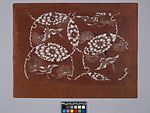katagami (Stencil)
About this object
History of use
The katazome method of dying fabric used a resist paste applied through a stencil; when the paste dried the stencil was removed and colour was applied by brush. The paste was then washed away leaving undyed areas to form pattern against coloured ground. Prior to the 16th century cut stencils were used to colour leather armour. However, during the Edo Period (1603-1868) the technique was developed as a true native craft.
Cultural context
fabric printing
Iconographic meaning
Chrysanthemum: longevity, sun, autumn, royal emblem; pine: longevity; crane: longevity, associated with mythical powers.
Physical description
The rectangular stencil has a cut design of four interlocking circles with scalloped edges, each enclosing a crane, two pine motifs and one to three chrysanthemum motifs. There are four register points along longest sides with two near the edge and two within the circles. Silk threads hold the open spaces of the design together. A white sheet is attached to the back of the stencil.
Categories
Materials
Cut Laminated Smoked Dried / paper Silk Persimmon juice
